The Honda Civic has evolved from a simple economy car into a style icon that captures hearts across generations. We’ve watched this beloved compact transform its aesthetic DNA while maintaining that perfect balance between sporty aggression and everyday practicality that makes it instantly recognizable on any street.
What makes the Civic’s design so captivating? It’s the way sharp angular lines meet smooth curves and how each generation pushes boundaries while respecting its heritage. From the sleek LED headlights to the distinctive rear spoiler we can’t help but admire the attention to detail that goes into every aesthetic element.
Whether you’re drawn to the Type R’s aggressive stance or the sedan’s refined elegance we’ll explore how Honda has mastered the art of creating a vehicle that looks as good as it performs. The Civic aesthetic isn’t just about appearances—it’s about making a statement every time you hit the road.
Understanding the Honda Civic Aesthetic Appeal
Honda’s design philosophy creates a visual language that speaks to automotive enthusiasts across multiple demographics. Our analysis reveals how the Civic aesthetic balances contemporary styling with timeless appeal.
Classic Design Elements That Define the Look
Clean geometric lines form the foundation of every Honda Civic aesthetic, creating a sophisticated silhouette that distinguishes the model from competitors. Sharp body creases extend from the headlights to the taillights, establishing visual continuity that makes the vehicle instantly recognizable on the road.
Distinctive front fascia design showcases Honda’s signature grille patterns, featuring hexagonal or trapezoidal shapes that vary across trim levels. Chrome accents frame the grille opening while integrating seamlessly with the headlight housings to create a cohesive front-end appearance.
Proportional balance defines the Honda Civic’s stance through carefully calculated dimensions between the wheelbase, overhangs, and greenhouse. Lower rooflines on coupe variants create a sportier profile, while sedan models maintain elegance through extended rear deck proportions.
Functional styling cues include rear spoilers, side skirts, and underbody panels that enhance both aesthetics and aerodynamics. These elements contribute to the vehicle’s performance while maintaining the visual appeal that defines modern Honda Civic design language.
Evolution of Civic Styling Through the Generations
First generation (1972-1979) established the compact car blueprint with simple rectangular forms and minimal ornamentation that emphasized functionality over flash. Boxy proportions and upright seating positions defined this era’s practical approach to automotive design.
Fifth generation (1991-1995) introduced curved body panels and integrated bumpers that marked Honda’s transition toward more sophisticated styling themes. Aerodynamic improvements included flush-mounted door handles and smoother body transitions that reduced wind noise.
Eighth generation (2005-2011) embraced bold angular designs with sharp character lines and aggressive front-end treatments that appealed to younger buyers. Two-tier dashboard layouts and futuristic interior elements reflected Honda’s commitment to innovative cabin aesthetics.
Current eleventh generation (2021-present) combines retro-inspired design cues with modern technology integration, featuring wider stances and more pronounced wheel arches. LED lighting signatures and premium material applications demonstrate Honda’s evolution toward luxury-oriented aesthetic appeals.
Choosing the Right Honda Civic Generation for Your Aesthetic Goals
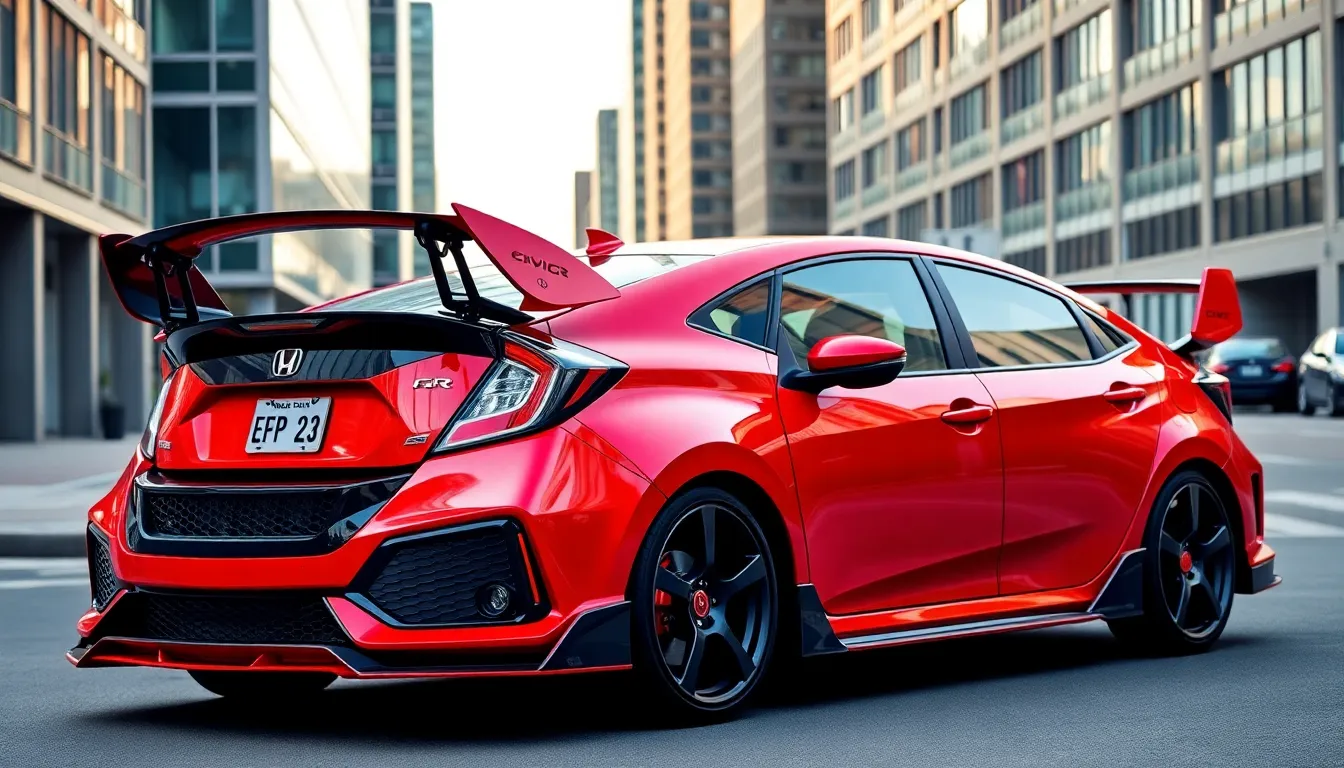
Selecting the perfect Honda Civic generation depends on your exact aesthetic vision and style preferences. We’ll explore three distinct eras that offer unique design approaches to help you achieve your desired look.
1990s EG and EK Hatchbacks for Retro JDM Vibes
EG Hatchbacks (1992-1995) capture the essence of 90s Japanese tuning culture with their compact proportions and clean bodylines. These models feature distinctive rounded headlights and minimal body cladding that creates a pure, unadorned aesthetic. Enthusiasts appreciate the EG’s lightweight construction and simple dashboard layout that embodies the “less is more” philosophy.
EK Generation (1996-2000) refined the retro formula with slightly more sophisticated styling cues while maintaining that authentic JDM character. Their angular rear spoilers and integrated fog lights provide subtle performance hints without overwhelming the design. Both generations offer extensive aftermarket support for authentic period modifications like Mugen body kits and classic JDM wheels.
2000s EP3 and FN2 Type R Models for Sporty Appeal
EP3 Type R (2001-2005) introduced aggressive styling elements that defined the early 2000s sport compact scene. Wide fender flares and prominent rear wings create an unmistakably performance focused silhouette. The model’s distinctive center mounted exhaust and lowered stance deliver visual drama that matches its track capabilities.
FN2 Type R (2007-2010) evolved the sporty aesthetic with more refined aerodynamic elements and sophisticated body sculpting. Integrated side skirts and subtle rear diffusers demonstrate Honda’s growing design maturity during this era. These models feature distinctive red Honda badges and unique alloy wheel designs that became iconic among Type R enthusiasts.
Modern 10th and 11th Generation Civics for Contemporary Style
10th Generation Civics (2016-2021) marked a dramatic shift toward bold, angular design language that appeals to younger demographics. Sharp character lines and distinctive C pillar treatments create ever-changing visual interest from every angle. The coupe variants feature particularly striking profiles with their sloping rooflines and integrated rear spoilers.
11th Generation Models (2021-present) blend contemporary minimalism with subtle performance cues for a mature yet captivating appearance. Cleaner body surfaces and refined proportions appeal to buyers seeking modern sophistication without sacrificing the Civic’s sporty DNA. LED lighting signatures and premium interior materials elevate the overall aesthetic experience to luxury car levels.
Essential Exterior Modifications to Enhance Honda Civic Aesthetic
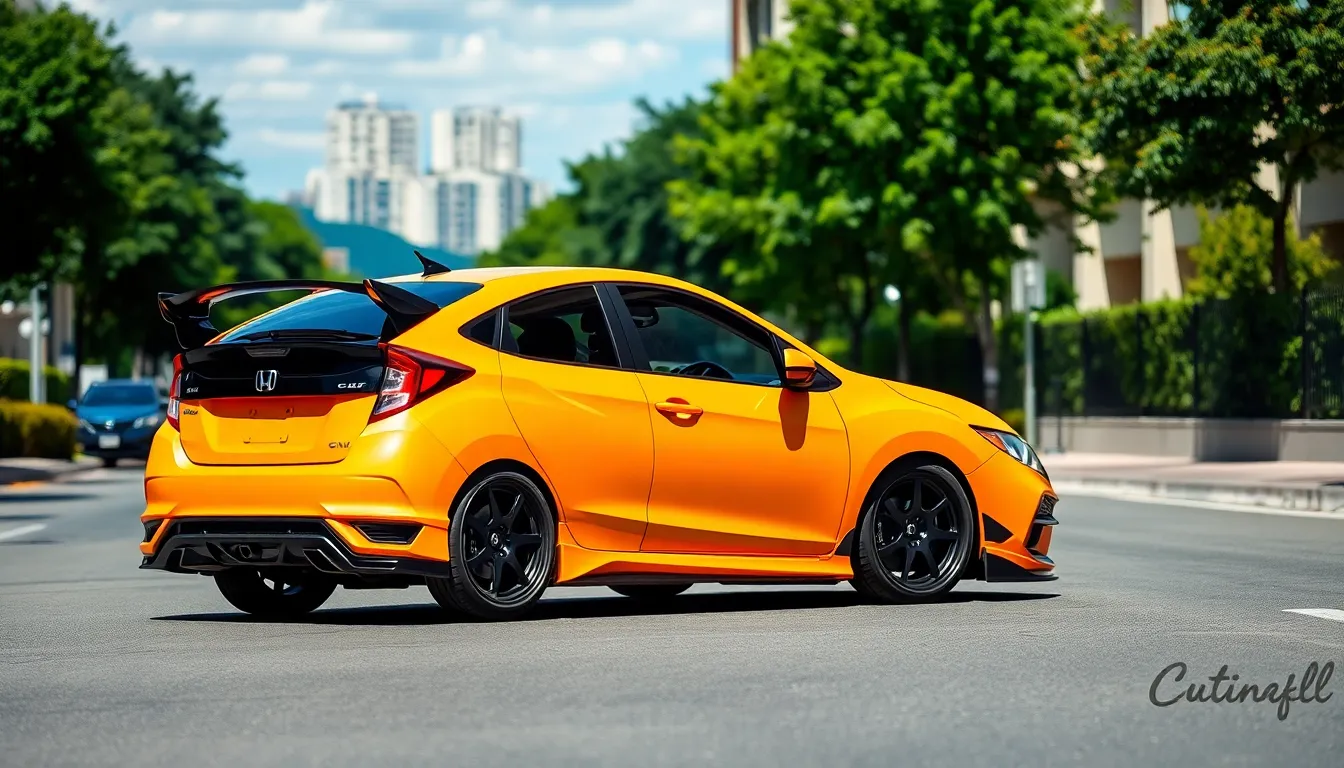
Transforming your Civic’s exterior appearance requires strategic modifications that complement its inherent design strengths. We’ll explore the most impactful upgrades that elevate your vehicle’s visual presence while maintaining functionality.
Lowering Springs and Coilovers for Perfect Stance
Lowering springs provide the foundation for achieving that coveted aggressive stance that transforms your Civic’s proportions. Progressive rate springs from manufacturers like Eibach Pro Kit typically drop the vehicle 1.4 inches front and 1.5 inches rear, creating a more planted appearance without compromising ride quality. H&R Sport Springs offer similar performance with a slightly more aggressive 1.6-inch drop that fills wheel wells perfectly.
Coilover systems deliver ultimate adjustability for enthusiasts seeking precise height control and handling refinement. KW Variant 1 coilovers allow height adjustments between 0.8 to 2.4 inches of lowering while maintaining dampening characteristics optimized for street driving. BC Racing BR Series coilovers provide 30-way dampening adjustment with swift springs that accommodate track use and daily driving scenarios.
Installation considerations require professional alignment after lowering to prevent premature tire wear and maintain proper suspension geometry. Quality aftermarket endlinks and camber arms become necessary when dropping more than 2 inches to preserve optimal wheel alignment angles.
Aftermarket Wheels and Tire Combinations
Wheel sizing dramatically impacts your Civic’s aesthetic presence, with 18×8.5 or 18×9.5 configurations providing the ideal balance between style and practicality. Popular options include Enkei RPF1 wheels in 18×9.5 ET45 that deliver lightweight performance with aggressive concave profiles. Work Emotion CR Ultimate wheels offer similar specifications with distinctive spoke patterns that complement the Civic’s modern design language.
Tire selection requires careful consideration of sidewall height to maintain proper proportions and ride comfort. We recommend 225/40R18 or 235/40R18 sizing that provides adequate sidewall protection while achieving that stretched appearance enthusiasts desire. Michelin Pilot Sport 4S and Continental ExtremeContact Sport tires deliver excellent performance characteristics in these dimensions.
Fitment specifications vary between generations, with 10th and 11th generation Civics accommodating wider wheels due to increased fender clearance. Hub centric rings ensure proper wheel centering on the 64.1mm hub bore, preventing vibrations and maintaining smooth operation at highway speeds.
Body Kit Options and Aerodynamic Upgrades
Front lip spoilers create immediate visual impact while improving aerodynamic efficiency at highway speeds. HFP (Honda Factory Performance) front lips provide OEM quality fitment with subtle aggression that complements stock bumpers perfectly. Maxton Design offers more pronounced options with carbon fiber construction that reduces weight while adding distinctive styling elements.
Side skirts and rear diffusers complete the aggressive aesthetic transformation by creating visual continuity along the vehicle’s profile. Mugen side skirts feature precise fitment with integrated mounting points that ensure long term durability. APR Performance rear diffusers incorporate functional design elements that improve airflow management while adding track inspired visual appeal.
Wing and spoiler options range from subtle deck lid extensions to full adjustable racing wings depending on your aesthetic goals. Type R style spoilers provide moderate downforce with distinctive visual presence, while APR GTC-300 adjustable wings deliver maximum aerodynamic performance for track focused builds. We recommend consulting aerodynamic specialists when selecting high downforce components to ensure proper balance and handling characteristics.
Interior Upgrades That Transform Your Honda Civic Aesthetic
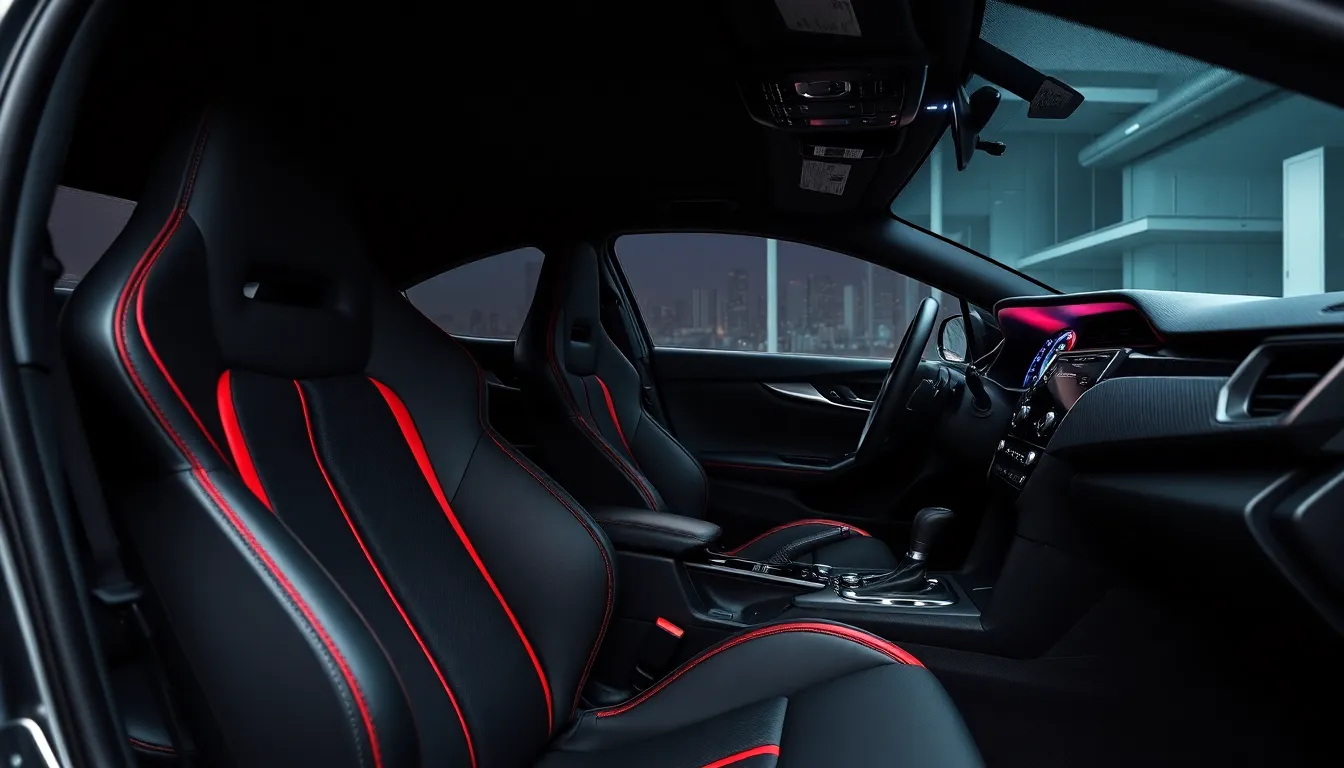
Moving beyond exterior modifications, we’ll explore how interior upgrades can completely transform your Civic’s cabin into a personalized aesthetic statement that matches your exterior vision.
Sport Seat Options and Upholstery Choices
Aftermarket racing seats elevate both comfort and visual appeal in your Honda Civic interior. Recaro SR series seats provide authentic racing heritage with their distinctive side bolster design, while Bride and Sparco options deliver aggressive styling that complements Type R aesthetics. We recommend choosing seats with mounting brackets specifically designed for your Civic generation to ensure proper fitment.
Custom upholstery materials allow you to create unique interior themes that reflect your personal style. Alcantara wrapping transforms stock seats into premium racing inspired surfaces, while leather options like Katzkin packages offer luxury aesthetics. Carbon fiber vinyl accents on seat backs create cohesive design themes when paired with exterior carbon components.
OEM Plus seating upgrades maintain factory reliability while improving visual impact. Honda Civic Type R seats retrofit into standard models with proper bracket modifications, delivering authentic performance aesthetics. Si model seats offer middle ground upgrades with sport bolstering and red accent stitching that enhances cabin ambiance.
Dashboard and Trim Modifications
Carbon fiber dash kits create immediate visual transformation throughout your Civic’s interior space. Real carbon fiber pieces from companies like Seibon provide authentic texture and depth, while quality vinyl wraps offer budget friendly alternatives. We suggest focusing on high visibility areas like center console trim and door panel inserts for maximum aesthetic impact.
Custom gauge bezels and trim rings add personalized touches that complement your overall design theme. Brushed aluminum pieces create modern industrial aesthetics, while colored anodized options match exterior accent colors. Spoon Sports and Mugen bezels provide authentic JDM styling that resonates with Honda enthusiast culture.
Interior lighting modifications dramatically enhance cabin ambiance during evening drives. LED strip installations under dash edges create subtle accent lighting, while colored footwell illumination matches exterior underglow themes. We recommend choosing colors that complement your seat stitching and trim accents for cohesive interior design.
Steering Wheel and Gauge Cluster Enhancements
Performance steering wheels serve as the primary driver interface and visual focal point in your Civic interior. Momo, Sparco, and OMP wheels offer various diameter and grip options to suit different driving styles. Deep dish designs create retro JDM aesthetics, while flat bottom configurations provide modern racing inspired looks.
Custom gauge cluster modifications transform your instrument panel into a personalized display. Indiglo gauge faces create distinctive nighttime illumination, while carbon fiber gauge rings add texture and depth. We suggest coordinating gauge colors with your interior lighting scheme for unified aesthetic presentation.
Quick release hubs and horn buttons complete the performance steering wheel installation while adding functional benefits. NRG and Sparco quick release systems allow easy wheel removal for security, while custom horn buttons featuring Honda badges or personal logos create finishing touches. These modifications require professional installation to maintain airbag safety systems in newer Civic models.
Popular Honda Civic Aesthetic Styles and Subcultures
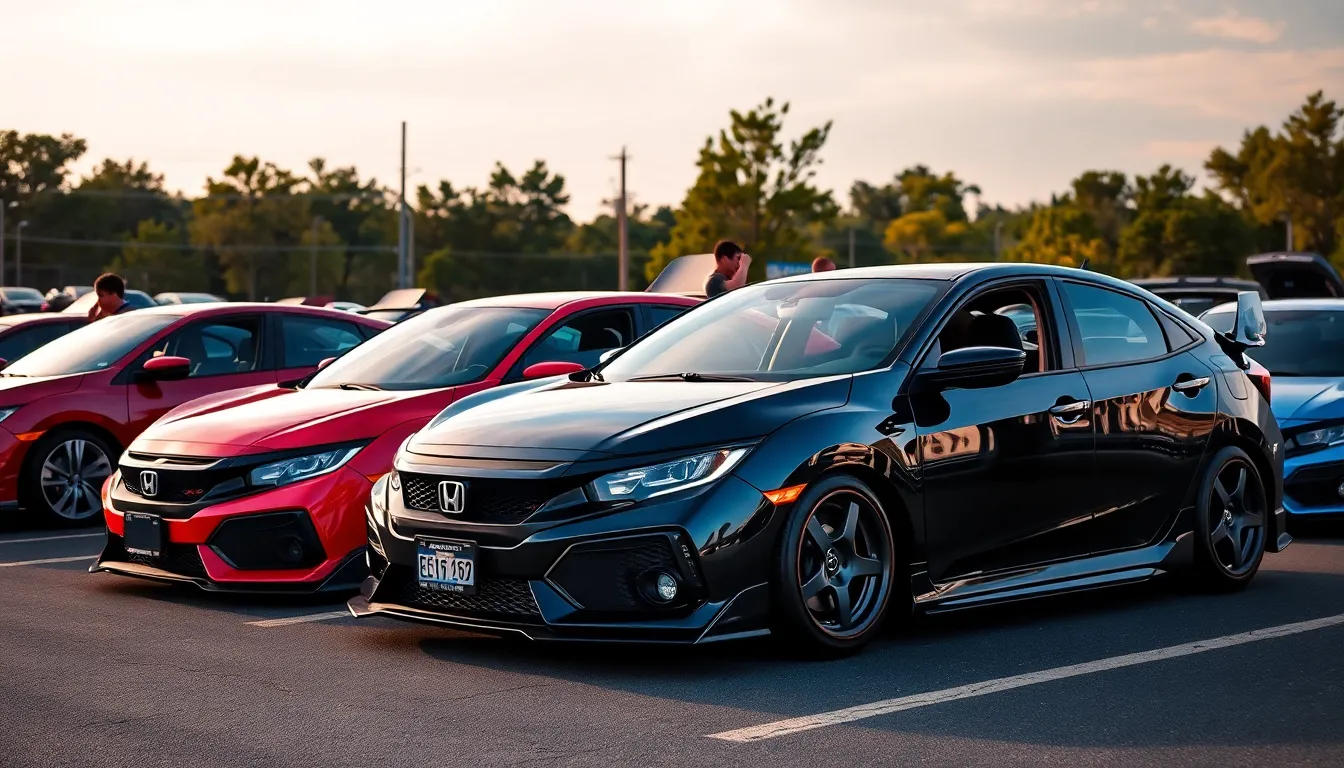
Different Honda Civic aesthetic styles reflect unique automotive cultures that have shaped the platform’s visual identity over decades. These subcultures create distinct communities where enthusiasts share common design philosophies and modification approaches.
JDM (Japanese Domestic Market) Styling Approach
JDM styling represents the authentic Japanese tuning philosophy that emphasizes clean lines, functional modifications, and subtle performance enhancements. We see this approach in builds featuring period-correct wheels like Spoon Sports SW388s, Mugen MF10s, and Work Emotion XD9s that maintain the Civic’s original proportions while adding visual depth.
Authentic JDM builds typically incorporate OEM+ modifications such as Honda Access side skirts, genuine Type R front lips, and Mugen rear spoilers that enhance the vehicle’s factory design language. Color schemes often feature classic Honda racing colors including Championship White, Nighthawk Black Pearl, and Milano Red that showcase the platform’s Japanese heritage.
Interior elements complete the JDM aesthetic through components like Recaro SR3 seats, Spoon Sports shift knobs, and Mugen steering wheels that blend performance functionality with authentic styling cues. We notice successful JDM builds maintain restraint in modification choices, focusing on quality components that enhance rather than overwhelm the Civic’s inherent design balance.
Stance Nation and Lowered Civic Builds
Stance culture transforms Honda Civics into rolling artwork through extreme lowering, stretched tire fitments, and aggressive wheel specifications that prioritize visual impact over practicality. We observe stance builds featuring air suspension systems from brands like Air Lift Performance and Accuair that allow dramatic height adjustments while maintaining daily drivability.
Wheel fitments in stance builds often push boundaries with sizes ranging from 18×9.5 to 19×10.5 inches, paired with tire stretching that creates distinctive sidewall profiles and emphasized wheel lips. Popular wheel choices include Rotiform RSE, Work Meister S1, and BBS RS models that provide the deep concave faces essential to stance aesthetics.
Camber adjustments create the signature tilted wheel appearance that defines stance culture, typically achieved through adjustable control arms, camber plates, and specialized suspension components. We find successful stance builds balance extreme visual elements with functional considerations, ensuring the vehicle remains drivable even though aggressive modifications.
Color matching between wheels, suspension components, and body panels creates cohesive visual themes that distinguish quality stance builds from basic lowered vehicles.
Type R Inspired Performance Aesthetic
Type R aesthetics emphasize aggressive functionality through aerodynamic enhancements, performance focused styling cues, and race inspired visual elements that communicate serious performance intentions. We see these builds incorporating front splitters, side canards, and rear diffusers that channel the hardcore aesthetic of Honda’s flagship performance models.
Body modifications often include wide fender flares, vented hoods, and prominent rear wings that create the muscular proportions associated with track focused vehicles. Popular aerodynamic brands like Seibon Carbon, VIS Racing, and Mugen provide components that maintain the Type R design language while accommodating different Civic generations.
Performance wheels such as Enkei RPF1, Rays Volk Racing TE37, and OZ Racing Ultraleggera complement the aggressive aesthetic while providing the lightweight construction necessary for serious performance applications. We notice Type R inspired builds typically feature sizes from 17×8 to 18×9.5 inches that balance visual impact with track functionality.
Paint schemes often incorporate racing stripes, color matched aerodynamic components, and performance graphics that reinforce the competition focused theme while maintaining visual cohesion across all exterior elements.
Color Schemes and Paint Options for Honda Civic Aesthetic
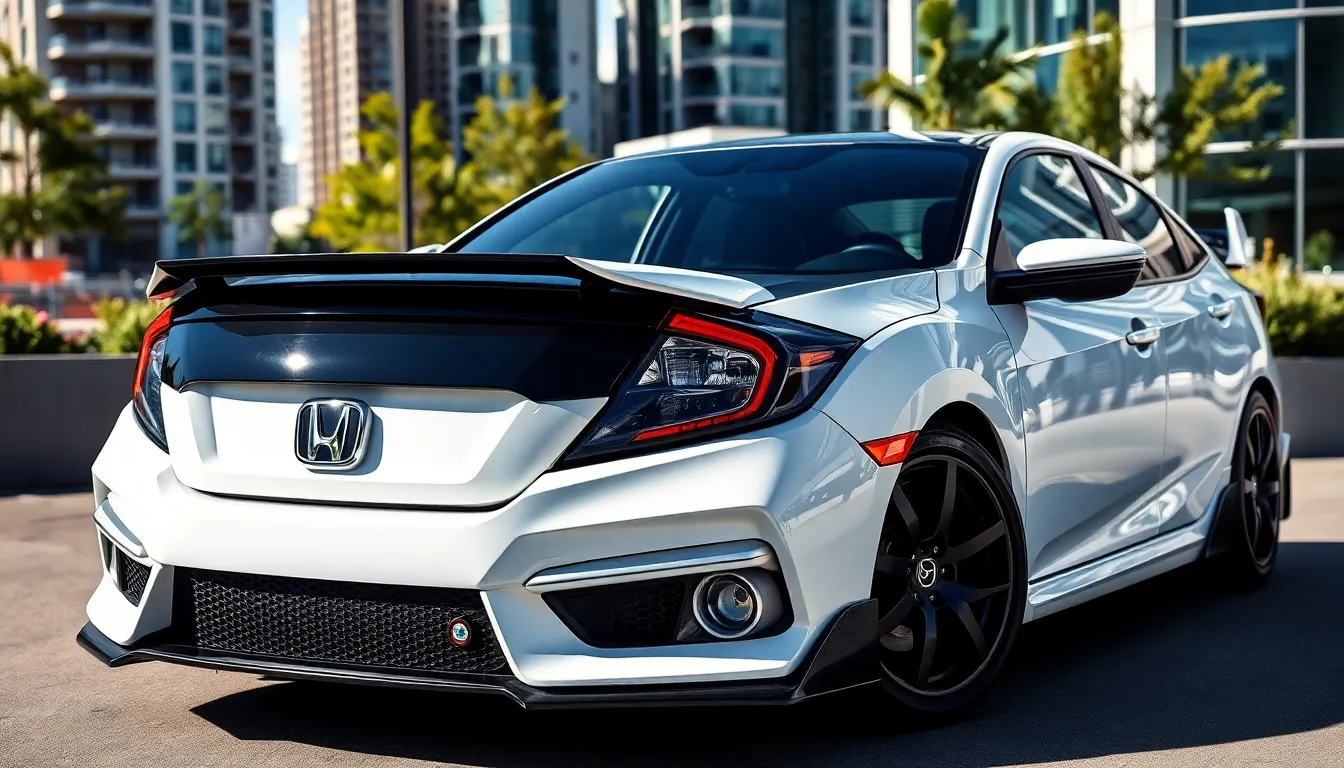
Choosing the right color scheme transforms your Honda Civic from ordinary to extraordinary. We’ll explore timeless classics, creative custom options, and striking combinations that enhance your Civic’s aesthetic appeal.
Classic Honda Colors That Never Go Out of Style
Championship White remains the most iconic Honda Civic color choice across all generations. This pure white finish became legendary through the Type R lineage and provides the perfect canvas for aftermarket modifications. Clean lines appear sharper while maintaining that classic JDM aesthetic that enthusiasts crave.
Milano Red delivers timeless Honda heritage with its deep metallic finish. We’ve seen this color on countless Civic Si models throughout the years. Bold presence on the road combines with excellent resale value retention.
Crystal Black Pearl offers sophisticated elegance that works across all Civic generations. Deep reflective properties showcase your vehicle’s body lines and aerodynamic modifications. Professional detailing reveals stunning depth that catches light beautifully.
Lunar Silver Metallic provides versatility that complements any modification style. We recommend this finish for stance builds and OEM Plus aesthetics. Subtle metallic flakes create dimension without overwhelming your chosen aesthetic direction.
Custom Paint Jobs and Vinyl Wrap Ideas
Matte finishes transform your Civic’s appearance with modern sophistication. Matte black, gunmetal gray, and midnight blue create striking contrasts against chrome trim pieces. Professional installation ensures proper adhesion and longevity for these specialized coatings.
Pearl and candy colors deliver show-stopping visual impact through multiple layer applications. Deep pearl white shifts between cream and silver tones under different lighting conditions. Candy apple red creates incredible depth that appears to glow from within.
Vinyl wrapping offers unlimited customization possibilities without permanent paint modifications. 3M and Avery Dennison provide premium materials in hundreds of color options. Installation costs range from $2,500 to $5,000 depending on complexity and finish quality.
Color-changing wraps represent the cutting edge of automotive aesthetics. Chameleon finishes shift between purple, green, and gold depending on viewing angle. These premium options typically cost $4,000 to $7,000 for professional application.
Two-Tone and Accent Color Combinations
Black roof combinations create dramatic contrast against lighter base colors. Championship White with gloss black roof delivers classic rally-inspired aesthetics. We’ve observed this combination gaining popularity across 10th and 11th generation Civic owners.
Carbon fiber accents provide sophisticated contrast without overwhelming your color scheme. Hood, mirrors, and spoiler components in carbon fiber complement any base color. These elements add performance visual cues while maintaining tasteful restraint.
Wheel and brake caliper coordination enhances your overall color theme through strategic accent placement. Bronze wheels pair beautifully with white or silver Civics. Red brake calipers create striking contrast against dark wheel finishes.
Window tint integration completes your two-tone aesthetic with functional benefits. 35% tint provides optimal visibility while improving color contrast. Professional ceramic tinting costs $300 to $600 but delivers superior heat rejection and UV protection.
Lighting Modifications to Complete Your Honda Civic Aesthetic
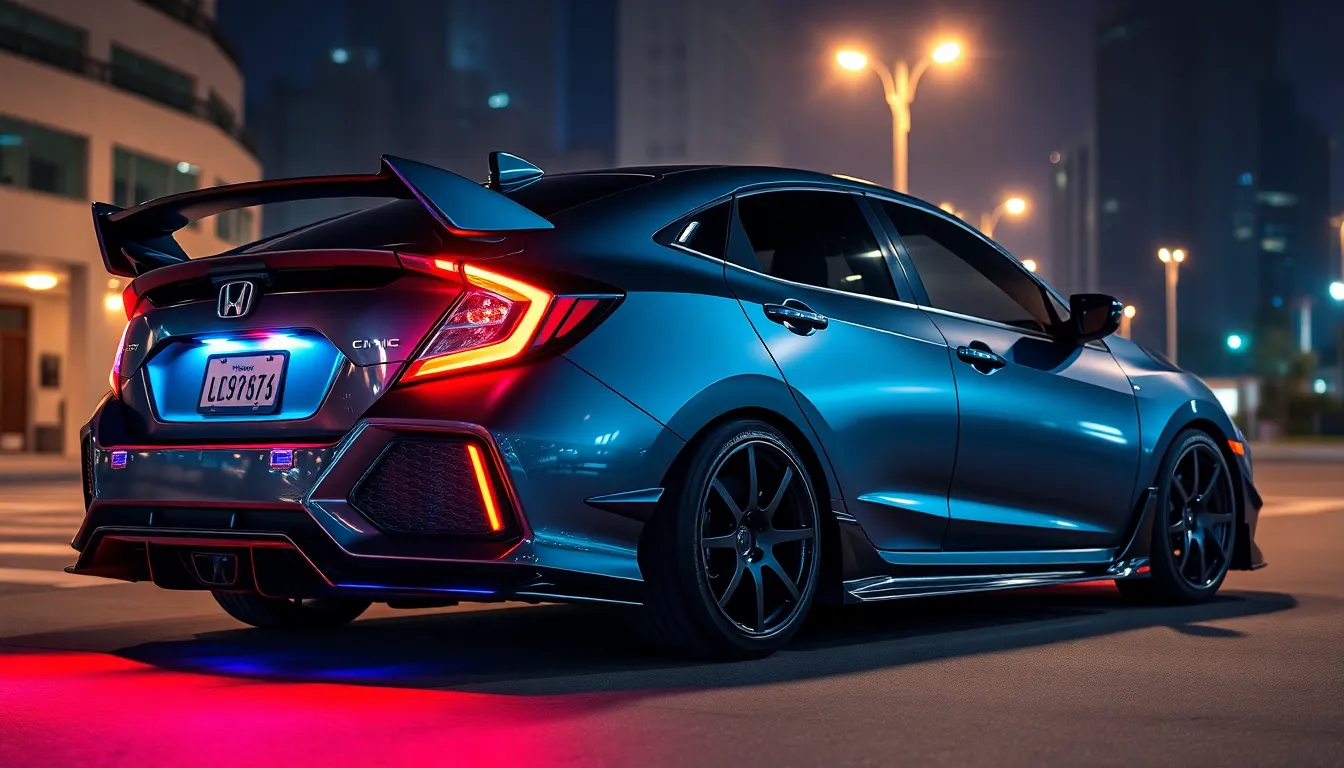
Strategic lighting upgrades transform your Honda Civic’s visual presence while improving functionality and safety. We’ll explore the most impactful lighting modifications that complement your chosen aesthetic direction.
LED Headlight and Taillight Upgrades
Premium LED headlight conversions deliver significantly improved visibility while creating a distinctive modern appearance. Morimoto XB LED headlights offer plug-and-play installation with sequential turn signals and customizable accent lighting that matches contemporary Civic design language. Brands like Spyder Auto and Spec-D Tuning provide budget-friendly alternatives with similar styling benefits at accessible price points.
Performance-oriented LED taillights enhance your Civic’s rear profile with sharper illumination patterns and faster response times. Sequential LED taillight assemblies create ever-changing turn signal animations that draw attention and improve safety during lane changes. Aftermarket options from companies like Vland and Akkon feature smoked lenses and custom light patterns that complement aggressive stance modifications.
Color temperature selection impacts your Civic’s overall aesthetic significantly, with 6000K producing crisp white light that matches modern OEM standards. Lower temperatures around 4300K create warmer output similar to luxury vehicles, while 8000K delivers blue-tinted illumination popular in JDM builds. We recommend maintaining consistent color temperatures across all exterior lighting elements for cohesive visual flow.
Angel eye and halo ring modifications add distinctive accent lighting that frames your headlight assemblies beautifully. RGB-capable halos allow color customization to match underglow systems or interior ambient lighting themes. Professional installation ensures proper electrical integration and prevents damage to sensitive LED components.
Underglow and Interior Ambient Lighting
Underglow lighting systems create dramatic ground effects that highlight your Civic’s lowered stance and wheel modifications. RGB LED strip kits from brands like Oracle Lighting and XK Glow offer smartphone app control with millions of color combinations and synchronized light shows. Single-color options in blue, red, or white provide classic aesthetic appeal while remaining street legal in most jurisdictions.
Interior ambient lighting upgrades transform your Civic’s cabin atmosphere with customizable illumination zones throughout the dashboard and door panels. Footwell lighting kits create subtle ground lighting that enhances nighttime visibility and adds luxury appeal. EL wire installations along trim pieces and cup holders provide continuous accent lighting that follows your interior’s contours seamlessly.
Smart lighting controllers enable synchronized operation between underglow and interior systems for comprehensive lighting themes. Bluetooth-enabled controllers allow real-time adjustments and preset programming that matches your driving mood or music rhythm. Sound-reactive modes create ever-changing light shows that pulse with bass frequencies and audio levels.
Professional installation considerations include proper wire routing to prevent damage from road debris and ensuring waterproof connections for underglow systems. We recommend consulting local regulations about underglow colors and usage restrictions before finalizing your lighting configuration.
Fog Light and Daytime Running Light Options
High-performance fog light upgrades improve visibility during adverse weather conditions while adding aggressive styling elements to your front bumper. LED fog light bulbs from Diode Dynamics and Auxbeam provide significantly brighter output than halogen alternatives with longer lifespan and lower power consumption. Yellow-tinted fog lights offer better penetration through rain and fog while creating distinctive vintage racing aesthetics.
Custom DRL integration allows your Honda Civic to feature signature lighting patterns that identify your vehicle during daylight hours. Switchback LED strips provide white DRL functionality that transitions to amber turn signals automatically. C-shaped and sequential DRL patterns create modern luxury vehicle appearance that elevates your Civic’s perceived value.
Projector fog light housings accept HID and LED bulb upgrades while providing focused beam patterns that reduce glare for oncoming traffic. Brands like Winjet and Spyder offer direct replacement units with clear or smoked lenses that match your headlight aesthetic. Halo ring integration adds accent lighting that connects visually with your headlight modifications.
Wiring harness upgrades ensure reliable operation of upgraded fog lights and DRL systems while preventing electrical system overload. Relay-based installations protect factory wiring from excessive current draw and provide independent switching control. We recommend professional electrical work for complex installations involving factory computer integration and automatic operation features.
Budget-Friendly Honda Civic Aesthetic Modifications
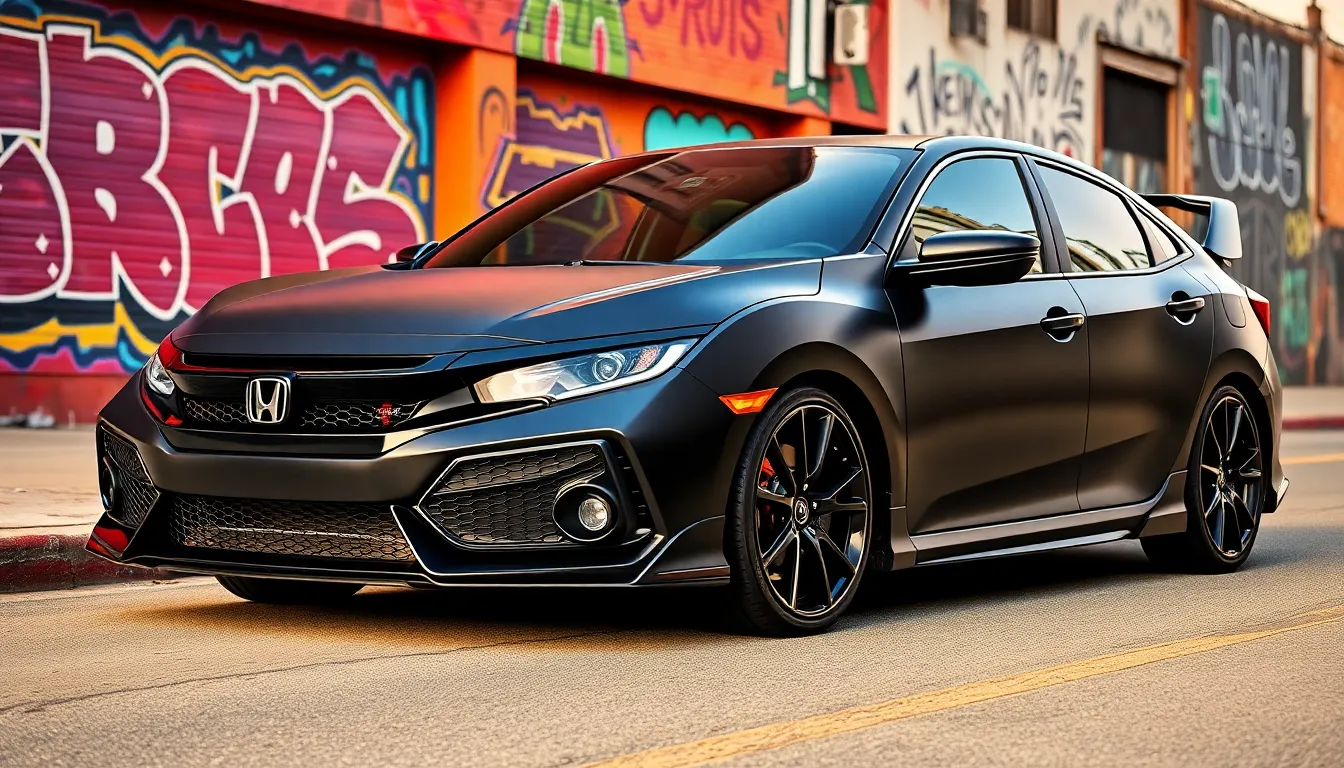
Transforming your Honda Civic’s aesthetic doesn’t require a massive budget or professional expertise. Smart modifications can deliver impressive visual results while keeping costs under control.
DIY Projects for Immediate Visual Impact
Plasti Dip applications offer the most affordable way to customize your Civic’s appearance instantly. We can transform chrome trim pieces, badges, and even wheels using this removable coating that costs under $20 per can. Application takes just minutes and provides a matte black finish that modernizes any generation Civic.
Vinyl decal installations create personalized styling for less than $50 in materials. Popular options include side stripe kits, window banners, and custom graphics that complement your chosen aesthetic direction. We recommend starting with simple geometric patterns or JDM inspired designs that enhance the Civic’s natural lines.
Badge removal and debadging costs nothing except time and delivers a clean OEM Plus appearance. Removing manufacturer emblems and model badges creates a minimalist look that’s particularly effective on newer generation Civics. Heat application and fishing line make this modification completely reversible.
Window tint installation ranks among the highest impact DIY projects for under $100 in materials. We suggest 35% ceramic tint for the optimal balance of aesthetics and visibility. This modification enhances privacy while giving your Civic a premium appearance that complements any color scheme.
Headlight and taillight tinting provides dramatic visual changes for approximately $30 in vinyl materials. Light smoke tint maintains functionality while creating a custom appearance that’s especially popular in stance and JDM communities.
Cost-Effective Exterior Enhancements
Aftermarket grille installations transform the Civic’s front fascia for $150 to $300. We recommend mesh style grilles that improve airflow while creating an aggressive appearance. Popular options include honeycomb patterns and Type R inspired designs that work across multiple generations.
Side marker light upgrades cost under $50 but significantly modernize older Civic models. Clear or smoked lens alternatives eliminate the amber appearance that dates these vehicles. LED versions provide brighter illumination while maintaining the clean aesthetic.
Mud flaps and splash guards serve dual purposes by protecting paint while adding visual interest for $60 to $120. Rally inspired designs work particularly well on hatchback models, while subtle OEM style options complement sedan applications.
Antenna modifications include short stubby antennas or complete removal for a cleaner roofline. These $20 to $40 upgrades eliminate the factory antenna’s visual disruption while maintaining radio functionality in most cases.
License plate frames and mounting answers provide finishing touches that cost $25 to $75. We prefer clean designs that don’t distract from the overall aesthetic, with options ranging from carbon fiber patterns to color matched alternatives.
Interior Styling on a Shoestring Budget
Seat cover installations dramatically change the cabin’s appearance for $80 to $200. We recommend sport inspired designs with contrasting stitching that complement your exterior modifications. Universal fit options work well for budget conscious enthusiasts who want immediate results.
Shift knob replacements offer one of the highest impact interior modifications for $30 to $100. Popular materials include aluminum, carbon fiber look plastics, and weighted options that improve the shifting experience while adding visual appeal.
Pedal cover installations enhance the sporty aesthetic for under $50 while improving grip during spirited driving. We suggest aluminum designs with rubber inserts that provide both function and form.
Floor mat upgrades replace worn factory options with custom alternatives for $60 to $150. All weather mats with logo designs or color accents create a cohesive interior theme that protects your investment.
Dashboard trim wrapping using carbon fiber vinyl costs $40 to $80 in materials while providing a dramatic transformation. This DIY project requires patience but delivers results that rival expensive OEM upgrades when executed properly.
Maintaining Your Honda Civic Aesthetic Over Time
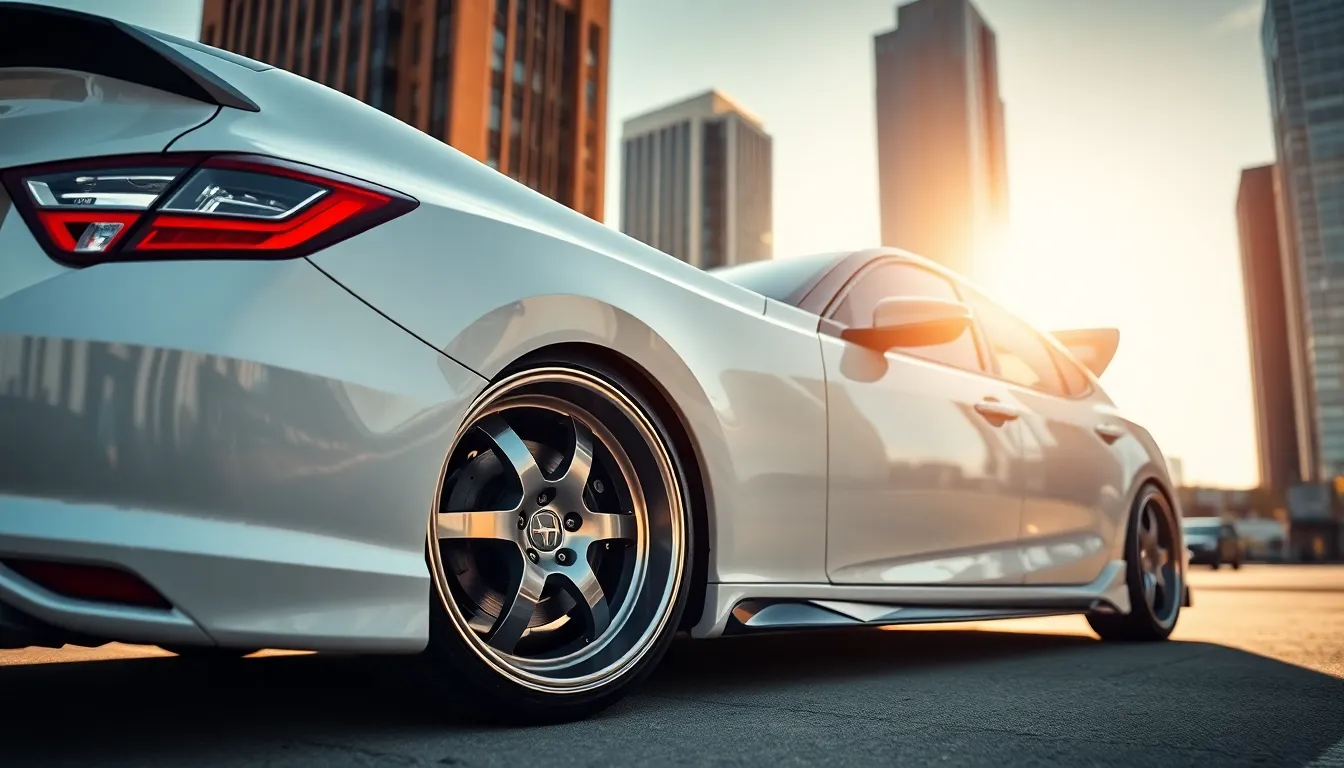
Maintaining your carefully crafted Honda Civic aesthetic requires consistent attention and strategic care. We’ll explore essential maintenance practices that preserve your modifications while protecting your investment over the years.
Proper Care for Modified Components
Aftermarket wheels demand specialized cleaning routines to prevent damage and maintain their visual appeal. Clean your custom wheels weekly using pH-balanced wheel cleaners and microfiber towels, avoiding harsh chemicals that can damage powder coatings or painted finishes. Apply wheel wax every three months to protect against brake dust and environmental contaminants.
Body kit components need regular inspection for cracks, chips, or loose mounting points that can compromise both aesthetics and safety. Check polyurethane and fiberglass pieces monthly for stress fractures, especially around mounting bolts and high-flex areas like side skirts and front lips. Touch up paint chips immediately using OEM color-matched paint pens to prevent rust formation.
Suspension modifications require frequent monitoring to ensure optimal performance and prevent premature wear. Inspect coilover seals every 3,000 miles for oil leaks, and adjust ride height seasonally to account for temperature-related spring rate changes. Document your suspension settings to maintain consistent stance after adjustments.
Performance exhaust systems benefit from periodic cleaning to remove carbon buildup and maintain their polished appearance. Use stainless steel cleaners monthly on tips and visible sections, while checking for loose clamps or damaged heat shields during routine maintenance.
Seasonal Maintenance Considerations
Winter weather poses unique challenges for Honda Civic aesthetics, particularly for lowered vehicles and exposed body modifications. Raise your coilover settings by 10-15mm during winter months to navigate snow and ice without damaging front lips or side skirts. Apply protective film to high-impact areas before winter to shield against road salt and debris.
Spring maintenance focuses on restoration after harsh winter conditions have taken their toll on your Civic’s appearance. Perform thorough undercarriage cleaning to remove salt deposits, inspect rubber seals for cracking, and replace any damaged trim pieces. Detail your vehicle completely using clay bar treatment followed by fresh wax application.
Summer heat affects various modification materials differently than other seasons, requiring adjusted care routines. Park in shaded areas whenever possible to prevent vinyl wraps from fading or peeling, and use UV protectant sprays on plastic trim pieces monthly. Check tire pressures weekly during hot weather, as lowered vehicles with wider tires are more susceptible to heat-related pressure changes.
Fall preparation involves protective measures against upcoming harsh weather conditions. Apply paint sealant before temperatures drop, inspect weatherstripping around modified panels, and consider temporary removal of fragile aesthetic pieces like front splitters if you live in areas with severe winter conditions.
Preserving Resale Value While Staying Stylish
Document all modifications with receipts and photos to demonstrate quality workmanship and proper installation to potential buyers. Create a modification portfolio including before and after pictures, receipts for parts and labor, and maintenance records for aftermarket components. Store original OEM parts in protective packaging to offer complete reversibility.
Choose reversible modifications whenever possible to maintain broad market appeal while expressing your aesthetic vision. Focus on bolt-on components like wheels, exhaust systems, and suspension rather than permanent alterations like body panel cuts or structural modifications. Quality aftermarket parts often add value when professionally installed and properly maintained.
Professional installation documentation increases resale confidence among potential buyers who value quality workmanship. Keep detailed records of which shops performed exact modifications, including alignment specifications, torque settings, and warranty information. Provide maintenance schedules for modified components to demonstrate responsible ownership.
Balance personal style with market preferences by selecting modifications that enhance rather than drastically alter the Civic’s original design language. Subtle aesthetic improvements like quality wheel upgrades, tasteful lowering, and OEM Plus styling typically maintain broader appeal than extreme modifications that limit your potential buyer pool.
Conclusion
The Honda Civic’s aesthetic journey proves that smart design choices can transform any generation into a stunning representation of personal style. Whether you’re drawn to the clean JDM approach or prefer aggressive stance modifications your Civic becomes a canvas for automotive expression.
We’ve explored how budget-conscious enthusiasts can achieve remarkable results through strategic modifications while maintaining the vehicle’s integrity. The key lies in understanding your aesthetic goals and choosing modifications that complement the Civic’s inherent design language.
Your Civic’s visual story doesn’t end with installation – it continues through proper maintenance and thoughtful documentation. By balancing personal creativity with timeless design principles you’ll create an aesthetic that stands the test of time while reflecting your unique automotive vision.
Frequently Asked Questions
What makes the Honda Civic’s design appealing across different generations?
The Honda Civic combines sharp lines with smooth curves, creating a perfect balance between sporty and practical elements. Its design features attention to detail with LED headlights, rear spoilers, and a sophisticated silhouette. Honda’s design philosophy creates a visual language that appeals to automotive enthusiasts across all demographics, from young buyers to mature drivers.
How has Honda Civic styling evolved through the generations?
The Civic started with simple rectangular forms in the 1970s, evolved to curved body panels in the 1990s, embraced bold angular designs in the 2000s, and now combines retro-inspired cues with modern technology. The current eleventh generation (2021-present) showcases Honda’s evolution toward luxury-oriented aesthetics while maintaining the Civic’s iconic appeal.
Which Honda Civic generation is best for aesthetic modifications?
It depends on your style preferences. The 1990s EG and EK hatchbacks offer retro JDM vibes with clean lines. The 2000s EP3 and FN2 Type R models provide aggressive styling for performance looks. The modern 10th and 11th generations feature contemporary designs that blend minimalism with sporty elements.
What are essential exterior modifications for Honda Civic aesthetics?
Key exterior modifications include lowering springs or coilovers for an aggressive stance, aftermarket wheels and tire combinations, body kits with front lip spoilers, side skirts, and rear diffusers. Wings and spoilers can enhance both aesthetics and aerodynamics. Professional consultation is recommended for significant modifications to ensure proper fitment and safety.
How can I upgrade my Honda Civic’s interior on a budget?
Affordable interior upgrades include custom seat covers, aftermarket shift knobs, dashboard trim wrapping with vinyl, and interior lighting modifications. DIY projects like badge removal, vinyl decal installations, and Plasti Dip applications can dramatically change the cabin’s appearance with minimal investment while delivering significant aesthetic improvements.
What are the most popular Honda Civic aesthetic styles?
The three main aesthetic styles are JDM (Japanese Domestic Market) with clean lines and functional modifications, stance culture featuring extreme lowering and aggressive wheel specifications, and Type R inspired builds focusing on aerodynamic enhancements and performance-oriented styling. Each style has distinct communities and modification approaches.
How do I maintain my Honda Civic’s aesthetic modifications?
Regular maintenance includes specialized cleaning routines for wheels, regular inspections of body kit parts, and seasonal adjustments for weather conditions. Document all modifications with professional installation records to maintain resale value. Balance personal style with market preferences, and choose reversible modifications when possible to preserve broad appeal.
Can I achieve good Honda Civic aesthetics without spending a lot of money?
Yes, budget-friendly modifications can deliver impressive results. DIY projects like Plasti Dip applications, vinyl installations, and chrome trim removal cost very little. Affordable exterior enhancements include aftermarket grilles, side marker upgrades, and mud flaps. These modifications are accessible to most enthusiasts while still providing significant visual improvements.


























